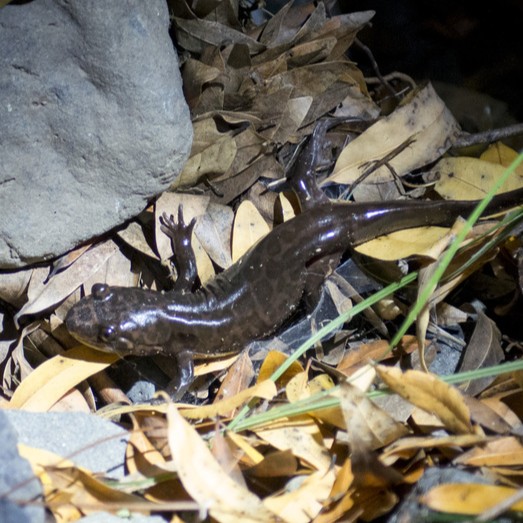Summary
The California giant salamander (Dicamptodon ensatus) is found in Mt. Tam’s streams and forests. This charismatic species’ aquatic-terrestrial life cycle, low vagility, longevity, large body size, and varied diet make it an excellent indicator of the health of those particular ecosystems. The One Tam area of focus constitutes a large portion of the species’ suitable forested habitat in Marin County. It is listed as Near Threatened by the IUCN and as a Species of Special Concern by the California Department of Fish and Wildlife, making it even more important to understand how they are faring. While metrics for this indicator need to be further developed, new technology (e.g., eDNA) and advances in crowdsourced data (e.g., iNaturalist) offer promising directions for the future to help address this information gap.
resources
Bury, R. B. (1972). Small mammals and other prey in the diet of the Pacific giant salamander (Dicamptodon ensatus). American Midland Naturalist, 87(2), 524–526. https://doi.org/10.2307/2423582
Davic, R. D., & Welsh, H. H. (2004). On the ecological roles of salamanders. Annual Review of Ecology, Evolution, and Systematics, 35(1), 405–434. https://doi.org/10.1146/annurev.ecolsys.35.112202.130116
Fellers, G. M., Wood, L. L., Carlisle, S., & Pratt, D. (2010). Unusual subterranean aggregations of the California giant salamander, Dicamptodon ensatus. Herpetological Conservation and Biology, 5(1), 149–154. https://tinyurl.com/2d66p44a
Fong, D., & Howell, J. A. (2006). Distribution and abundance of California giant salamander (Dicamptodon ensatus) and signal crayfish (Pacifastacus leniusculus) in the upper Redwood Creek watershed, Marin County, California (Open-File Report No. 2006–106). U.S. Geological Survey. https://doi.org/10.3133/ofr20061066
Foster, A. D., & Olson, D. H. (2014). Conservation assessment for the Cope’s giant salamander (Dicamptodon copei) (Ver. 1.0; Interagency Special Status/Sensitive Species Program). U.S. Forest Service. https://www.fs.usda.gov/pnw/pubs/journals/pnw_2014_foster001.pdf
GBIF.org. (2022). GBIF occurrence download Dicamptodon ensatus [Data set]. The Global Biodiversity Information Facility. Retrieved December 22, 2022, from https://doi.org/10.15468/DL.4TD65J
GBIF.org. (2023). 100 of the world’s worst invasive alien species [Database]. The Global Biodiversity Information Facility. Retrieved February 22, 2023, from http://www.iucngisd.org/gisd/100_worst.php
Good, D. A. (1989). Hybridization and cryptic species in Dicamptodon (Caudata: Dicamptodontidae). Evolution, 43(4), 728–744. https://doi.org/10.1111/j.1558-5646.1989.tb05172.x
Gray, M. J., Lewis, J. P., Nanjappa, P., Klocke, B., Pasmans, F., Martel, A., Stephen, C., Parra Olea, G., Smith, S. A., Sacerdote-Velat, A., Christman, M. R., Williams, J. M., & Olson, D. H. (2015). Batrachochytrium salamandrivorans: The North American response and a call for action. PLoS Pathogens, 11(12), e1005251. https://doi.org/10.1371/journal.ppat.1005251
Halstead, B. J., Kleeman, P. M., Goldberg, C. S., Bedwell, M., Douglas, R. B., & Ulrich, D. W. (2018). Occurrence of California red-legged (Rana draytonii) and northern red-legged (Rana aurora) frogs in timberlands of Mendocino County, California, examined with environmental DNA. Northwestern Naturalist, 99(1), 9–20. https://doi.org/10.1898/NWN17-17.1
iNaturalist. (2022). FAQ: What is geoprivacy? What does it mean for an observation to be obscured? https://www.inaturalist.org/pages/help#geoprivacy
iNaturalist Community. (2020). Observations of Dicamptodon ensatus from Marin County, California, USA, observed between 2011–2020 [Data set]. iNaturalist. Retrieved August 8, 2022, from https://www.inaturalist.org/observations?place_id=2319&taxon_id=26823
Kessel, E., & Kessel, B. (1943a). Rate of growth of the older larvae of the Pacific giant salamander, Dicamptodon ensatus (Eschscholtz). Wasmann Collector, 5(3), 141–142.
Kessel, E., & Kessel, B. (1943b). The rate of growth of the young larvae of the Pacific giant salamander, Dicamptodon ensatus (Eschscholtz). Wasmann Collector, 5(4), 108–111.
Lannoo, M. J. (Ed.). (2005). Amphibian declines: The conservation status of United States species. University of California Press.
Lavin, B. R., Callahan, B. S., Connell, R. A., & Girman, D. J. (2021). Phylogeography and genetic structure in the California giant salamander (Dicamptodon ensatus): Impacts of current and historic landscape features. Zootaxa, 5068(1), 60–80. https://doi.org/10.11646/zootaxa.5068.1.2
Martel, A., Spitzen-van der Sluijs, A., Blooi, M., Bert, W., Ducatelle, R., Fisher, M. C., Woeltjes, A., Bosman, W., Chiers, K., Bossuyt, F., & Pasmans, F. (2013). Batrachochytrium salamandrivorans sp. nov. causes lethal chytridiomycosis in amphibians. Proceedings of the National Academy of Sciences, 110(38), 15325–15329. https://doi.org/10.1073/pnas.1307356110
Moskal, E. (2022, January 26). Volunteers save thousands of newts from becoming roadkill. Bay Nature. https://tinyurl.com/yp7dzknp
North American Bsal Task Force [NABTF]. (2022). A North American strategic plan to prevent and control invasions of the lethal salamander pathogen Batrachochytrium salamandrivorans. www.salamanderfungus.org
Nussbaum, R. A. (1969). Nests and eggs of the Pacific giant salamander, Dicamptodon ensatus (Eschscholtz). Herpetologica, 25(4), 257–262. https://www.jstor.org/stable/3891216
Parker, M. S. (1994). Feeding ecology of stream-dwelling Pacific giant salamander larvae (Dicamptodon tenebrosus). Copeia, 1994(3), 705. https://doi.org/10.2307/1447187
Parsons, A., & Valtierra, H. (2019, February 6). Traffic is driving a newt massacre in the Santa Cruz mountains. Bay Nature. https://tinyurl.com/y77any37
Pilliod, D. S., Goldberg, C. S., Arkle, R. S., & Waits, L. P. (2014). Factors influencing detection of eDNA from a stream-dwelling amphibian. Molecular Ecology Resources, 14(1), 109–116. https://doi.org/10.1111/1755-0998.12159
Richgels, K. L. D., Russell, R. E., Adams, M. J., White, C. L., & Grant, E. H. C. (2016). Spatial variation in risk and consequence of Batrachochytrium salamandrivorans introduction in the USA. Royal Society Open Science, 3(2), 150616. https://doi.org/10.1098/rsos.150616
Smith, H. M. (1949). Size maxima in terrestrial salamanders. Copeia, 1949(1), 71. https://doi.org/10.2307/1437669
Stebbins, R. C., & McGinnis, S. M. (2011). Field guide to amphibians and reptiles of California (Rev. ed). University of California Press.
Waddle, J. H., Grear, D. A., Mosher, B. A., Grant, E. H. C., Adams, M. J., Backlin, A. R., Barichivich, W. J., Brand, A. B., Bucciarelli, G. M., Calhoun, D. L., Chestnut, T., Davenport, J. M., Dietrich, A. E., Fisher, R. N., Glorioso, B. M., Halstead, B. J., Hayes, M. P., Honeycutt, R. K., Hossack, B. R., … Winzeler, M. E. (2020). Batrachochytrium salamandrivorans (Bsal) not detected in an intensive survey of wild North American amphibians. Scientific Reports, 10(1), 13012. https://doi.org/10.1038/s41598-020-69486-x
Welsh, H. H., Cummings, A. K., & Hodgson, G. R. (2019). Metrics of disturbance in a redwood forest ecosystem: Responses of stream amphibians to repeated sediment infusions. Ecosphere, 10(10), e02886. https://doi.org/10.1002/ecs2.2886
Welsh, H. H., & Ollivier, L. M. (1998). Stream amphibians as indicators of ecosystem stress: A case study from California’s redwoods. Ecological Applications, 8(4), 1118–1132. https://doi.org/10.2307/2640966Wiens, J. J. (2007). Global patterns of diversification and species richness in amphibians. The American Naturalist, 170(S2), S86–S106. https://doi.org/10.1086/519396

